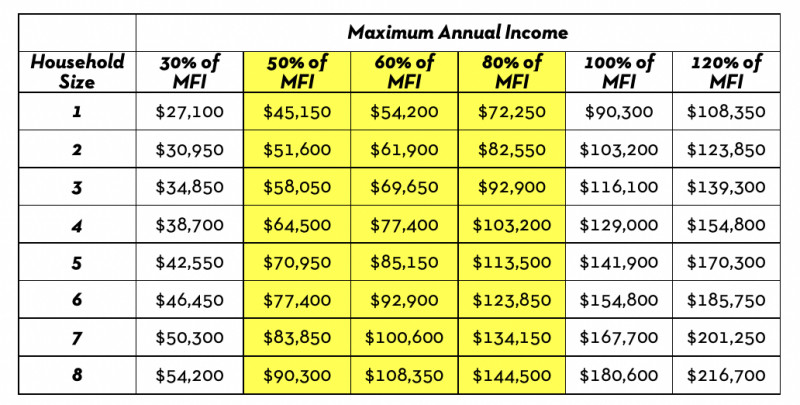Affordable housing eligibility is based on median income — and the 2021 numbers are out for DC

Apartments in DC by Elvert Barnes licensed under Creative Commons.
Affordable housing in DC can be built through Inclusionary Zoning, with funding from the Housing Production Trust Fund, or through any of the myriad other programs in the District’s affordable housing toolkit. But all of these programs have one thing in common: their income limits and rental costs are based on a figure called the Median Family Income (MFI).
The Median Family Income — which used to be called the Area Median Income, a term you might be more familiar with — is calculated by the US Department of Housing and Urban Development (HUD) every year, broken down by geography. DC uses the MFI for the Washington Metropolitan Statistical Area to calculate its income limits for programs such as Inclusionary Zoning.
HUD released its latest estimates in April, and DC published new guidance for Inclusionary Zoning limits this month. (A note here: these exact limits are specifically calculated for IZ — other program calculations could vary.)
Here’s what the new numbers look like, and how they’ve changed over the last year.
Income limits
DC’s MFI in 2021 is $129,000 for a household of four. That number represents a 2.4% increase over the previous year’s MFI of $126,000 (usually in recent years, that figure increases by more than 3%, according to the Department of Housing and Community Development.)
DC then calculates income limits based on percentages of that median income, adjusting by household size.
Maximum annual income limits for Inclusionary Zoning units. Image from DHCD/DMPED. 
This table has implications for what it really means when a project includes affordable housing.
In the Inclusionary Zoning program, which requires some new construction to include affordable units, the typical unit is a studio or one-bedroom apartment set at 80% MFI limits. Such a unit would serve a single person making as much as $72,250. A family of four could be making more than $100,000.
Much of the criticism around affordable housing programs is that they do a lot for middle-income families like that, but not as much for very low-income families — who, in DC as elsewhere, are disproportionately Black.
DC’s new Comprehensive Plan, which passed the DC Council in May and is moving through the process to becoming law, is trying to address that issue by defining “deeply affordable” housing as housing for people making below 40% of the MFI.
Rent and purchase price limits
Housing cost limits for IZ units in multi-family developments. Image from DHCD/DMPED. 
In addition to income limits, DC sets maximum rent and purchase costs based on those limits. The idea is that someone within that income threshold shouldn’t have to spend more than 30% of their income on housing.
This means that rental costs vary widely based on what income threshold an affordable unit is set aside for. For instance, a two bedroom apartment for a family making less than 30% MFI would cost no more than $830 — a number you’d be hard pressed to find in DC on the private market.
If that same apartment were set aside for a family making 80% MFI, however, it would cost $2,220. You can find two bedroom apartments for that price on the market all over the District.
Of course, that doesn’t mean the available apartments at that price point meet the demand. A 2019 Urban Institute report found that the region needs to build much more middle-cost housing to meet future demand, finding that even middle-income households face housing cost burdens.
Like income limits, the maximum rent and purchase prices for 2021 are higher than the year before. That two bedroom apartment at 80% MFI costing $2,200 would have cost up to $2,160 last year.
The changes in housing cost limits aren’t exactly tied to income. Since 2018 DC has limited the increases to 3% even when the MFI rose more than that, in order to keep the program predictable. That means the housing costs have been set at less than the 30%-of-income limit. So this year, even though MFI rose less than 3%, DC still raised the housing cost limits by 3% to get closer to that 30% threshold.
